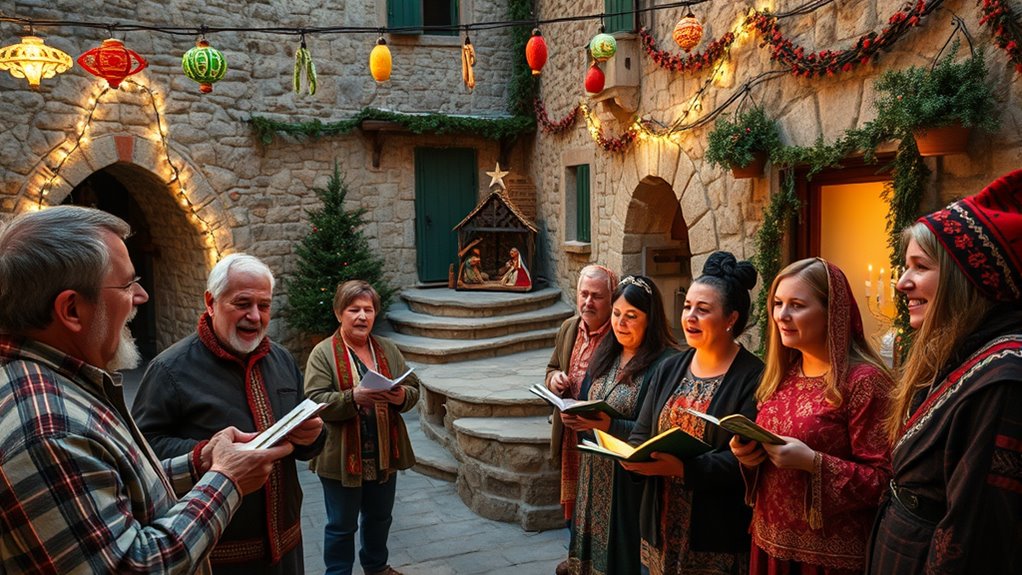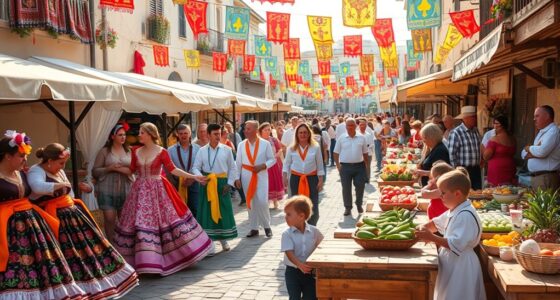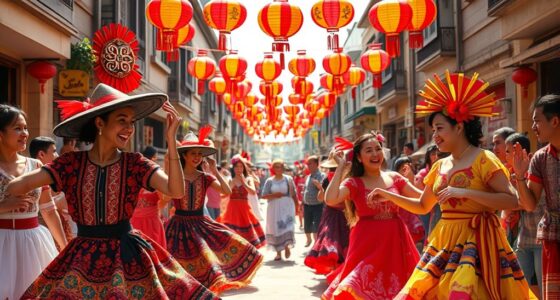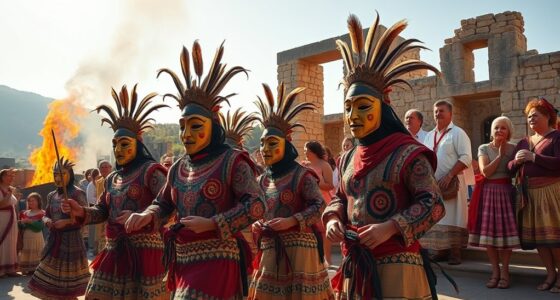In Ittiri, the songs of Sos Tres Re are a essential part of Christmas traditions, blending Sardinian cultural heritage with religious devotion. You’ll witness polyphonic singing, community participation, and rituals like candle lighting and church services that reinforce local identity. Music, traditional instruments, and festive performances are deeply woven into holiday celebrations. If you want to explore how these songs connect faith, culture, and community, there’s more to uncover about this cherished tradition.
Key Takeaways
- Sos Tres Re is a traditional Sardinian polyphonic song integral to Christmas celebrations in Ittiri.
- The songs are transmitted orally across generations, often performed door-to-door for treats.
- They are woven into rituals like midnight mass and festive processions, symbolizing religious devotion.
- The number three in the songs symbolizes unity, divine harmony, and the Holy Trinity.
- Modern initiatives, including performances and digital sharing, help preserve and promote Sos Tres Re traditions.
The Significance of Sos Tres Re in Sardinian Christmas Celebrations
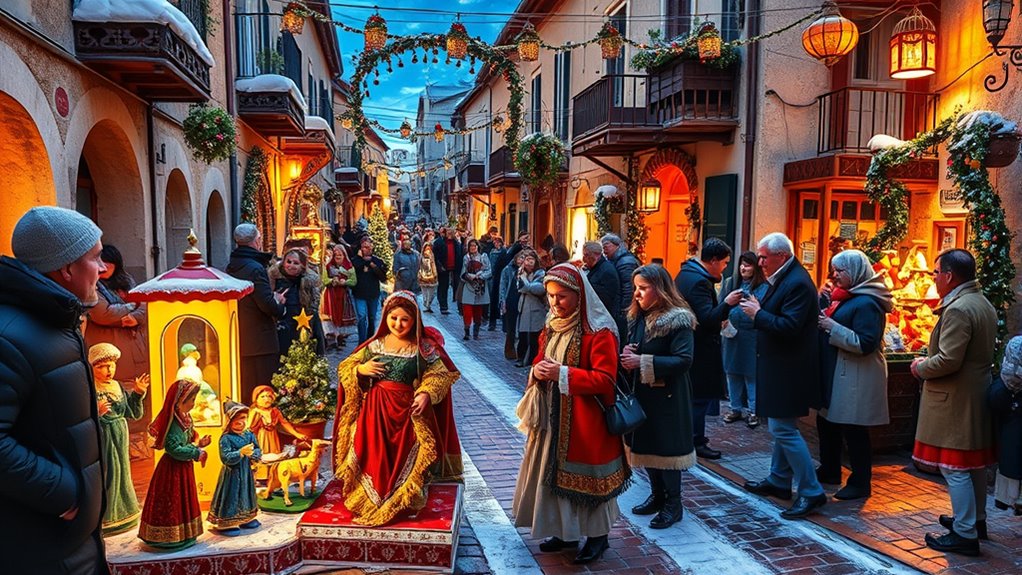
Sos Tres Re holds a special place in Sardinian Christmas celebrations because it embodies the island’s blend of religious faith and rich cultural heritage. When you hear children singing *Sos Tres Re* on January 6th, you’re witnessing a tradition rooted in honoring the Three Kings and their journey to Bethlehem. This custom keeps the festive spirit alive, especially in northern towns like Ittiri. Kids go door-to-door, singing the song in exchange for treats like sweets and coins, reinforcing community bonds. Landlords reward the children for their performances, preserving a sense of shared joy and generosity. Although less widespread today, this tradition continues to symbolize hope, faith, and the enduring cultural identity of Sardinia. It’s a lively reminder of the island’s festive, familial spirit. Cultural heritage plays a vital role in maintaining these customs, ensuring they are passed down through generations.
Traditional Songs and Their Role in Ittiri’s Festive Spirit

Traditional songs play a vital role in shaping Ittiri’s festive spirit by fostering a sense of community and celebration. As you participate in singing and listening, you feel the unity these melodies bring, especially during key moments like processions and street festivities. Music, with instruments like the zampogna and Launeddas, enhances the emotional depth, connecting you to Sardinian heritage. Across generations, singing and playing traditional instruments keep cultural continuity alive, strengthening local identity and pride. These songs often tell stories of history and faith, making the festivities more meaningful. Whether through devotional hymns or lively folk tunes, the communal participation in music sustains Ittiri’s festive atmosphere and celebrates its unique cultural legacy.
The Connection Between Sos Tres Re and Religious Observances
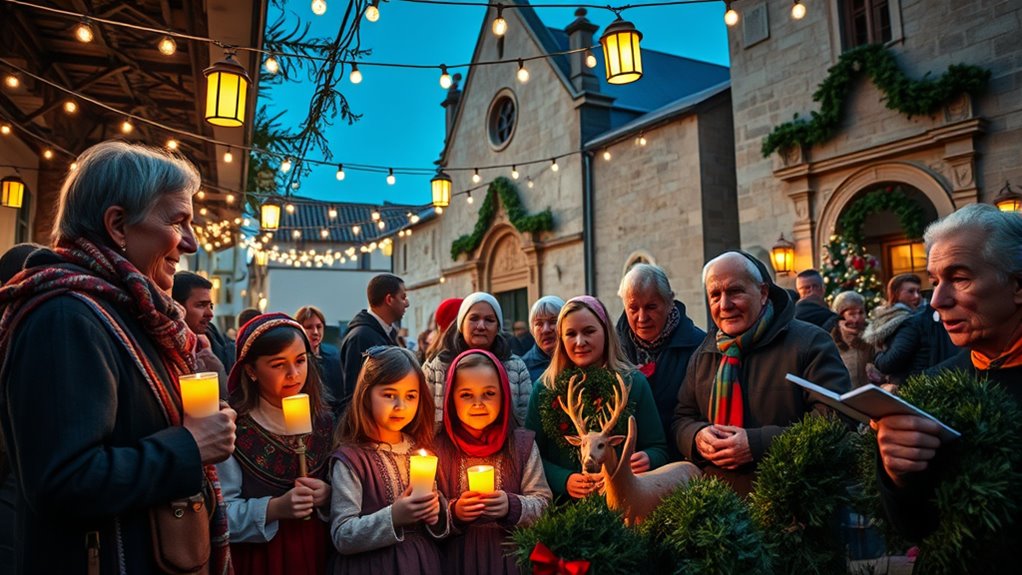
You can see how Sos Tres Re songs are closely tied to sacred rituals and celebrations, serving as more than just music—they’re acts of devotion. Their lyrics are rich with symbols that highlight key moments in religious festivities, creating a shared spiritual experience. By understanding these connections, you’ll appreciate how music and faith intertwine in Ittiri’s traditions. Santeria practices often incorporate these songs to invoke the spirits and reinforce spiritual bonds during important religious observances. Additionally, the cultural significance of these songs ensures their preservation and continued relevance in community rituals.
Rituals and Sacred Songs
In Ittiri, during Christmas, sacred songs are more than just melodies—they are essential parts of religious rituals that deepen communal faith. Sos Tres Re songs are performed during key moments like Midnight Mass and Christmas Eve vigils, reinforcing the Nativity story. As you participate, you’ll notice the polyphonic singing, often in churches or communal gatherings, creating a sacred atmosphere. These songs are usually sung a cappella, emphasizing harmony and spiritual reflection. Rituals surrounding the singing, such as processions, candle lighting, incense, and scripture readings, enhance their spiritual significance. Participation is often a collective act across generations, strengthening bonds and preserving tradition. Sos Tres Re serves both as a religious act and a cultural expression, linking faith with community identity during the Christmas season. Traditional singing practices also play a vital role in maintaining the cultural heritage of Ittiri, ensuring these sacred melodies are passed down through generations. Additionally, the cultural significance of these songs helps reinforce local identity and communal cohesion during the holiday celebrations.
Symbolism in Religious Celebrations
The number three holds profound symbolic significance in Sos Tres Re and related religious observances, representing unity, completeness, and divine harmony. You’ll notice this triadic pattern reflects the Christian Holy Trinity—Father, Son, and Holy Spirit—and aligns with ancient Celtic and Mediterranean traditions, where threefold concepts symbolize cosmic order and spiritual power. The three kings or figures in Sos Tres Re symbolize divine authority and religious legitimacy, emphasizing spiritual harmony. During Christmas, singing Sos Tres Re connects the community to the birth of Christ and the Magi’s visit, reinforcing Christian themes. The repeated use of three in the song strengthens its role as a vessel for religious teaching, fostering community cohesion by embodying sacred unity and spiritual balance rooted in longstanding cultural and theological symbolism. Incorporating vintage decor and traditional elements into the celebration can also reflect the historical roots and cultural significance of these customs.
Musical Instruments and Performances During Christmas in Ittiri

During Christmas in Ittiri, traditional instruments like the zampogna, flutes, and drums bring the festive spirit to life. You’ll notice how polyphonic choirs sing ancient Sardinian songs, adding a spiritual dimension to celebrations. These musical performances connect community, culture, and the pastoral roots of the season.
Traditional Instruments Used
Traditional Christmas celebrations in Ittiri showcase a rich variety of instruments that bring the festive spirit to life. You’ll hear the haunting melodies of launeddas, played with circular breathing, creating a sacred soundscape. The zampogna bagpipes, often played by local zampognari, infuse the air with rustic charm. Simple flutes and whistles accompany carols, while rustic horns add a pastoral touch. These wind instruments, together with stringed tools like guitars, mandolins, and violins, form vibrant ensembles. Percussion instruments like tambourines, small drums, and wooden clappers keep the rhythm alive. Instruments are combined in regional ensembles to produce lively, traditional performances during Christmas, blending sacred melodies with community celebration.
| Wind Instruments | String Instruments |
|---|---|
| Launeddas | Cantu a chiterra |
| Zampogna | Traditional guitars |
| Bena | Mandolins and lutes |
| Flutes and whistles | Violins |
| Horn instruments | Simple plucked instruments |
Musical Performances and Roles
In Ittiri’s Christmas celebrations, musical performances center around vibrant choral groups that bring polyphonic singing to life. The Polyphonic Association of St. Francis organizes a festive event featuring these rich vocal arrangements. The Monte Gonare choir also hosts a late December concert, adding to the local musical traditions. You’ll notice that performances focus on polyphonic singing, a Sardinian vocal style with multiple independent melodies. Choir members mainly sing, guided by lead singers who improvise within structured pieces. Occasionally, they’re supported by hand percussion or clapping, enhancing the harmony. Elderly singers mentor younger voices, ensuring the tradition endures. These performances often take place in churches or public squares, creating a reverent yet lively atmosphere that connects the community through shared musical heritage. Additionally, the emphasis on polyphonic singing reflects a deep-rooted cultural practice that has been preserved and passed down through generations.
Community Involvement and the Transmission of Song Traditions

Community involvement plays a vital role in keeping the Sos Tres Re song traditions alive in Ittiri. You see, singing these songs is a collective effort, engaging all age groups during Christmas gatherings and in communal spaces like town squares. Family and neighborhood participation strengthen bonds, while preparing traditional foods links culinary and musical customs. Songs are passed down orally from elders to younger generations through informal settings like family events and community gatherings. Repetition and storytelling preserve lyrics and melodies, ensuring cultural understanding. These traditions are woven into larger Christmas rituals, such as lighting the “su truncu e’xena” log and midnight mass. Public performances and school initiatives further reinforce the importance of transmitting these songs, fostering community pride and safeguarding intangible cultural heritage. This oral tradition is essential for the preservation of Sardinian cultural identity, ensuring that future generations continue to cherish and practice these unique festive songs.
Preserving and Celebrating Sos Tres Re in Modern Ittiri

Preserving and celebrating Sos Tres Re in modern Ittiri involves a dynamic blend of old and new practices that keep the tradition alive. You can experience this through family-led oral transmission, ensuring authenticity, and by participating in workshops at local schools and cultural associations. Digital media plays an essential role, sharing recordings and reaching wider audiences. Performances typically occur during Christmas Eve and Epiphany, accompanied by traditional instruments like violins and launeddas, often in villages squares or churches. Community events, feasts, and religious processions serve as key venues. To adapt, younger generations engage through modernized formats, blending tradition with contemporary styles. This approach fosters pride, maintains cultural relevance, and helps safeguard Sos Tres Re for future generations. Embracing cultural preservation initiatives ensures these traditions continue to thrive in the modern age.
Frequently Asked Questions
How Did Sos Tres Re Originate in Sardinian Christmas Customs?
You might wonder how Sos Tres Re started in Sardinian Christmas customs. It originated from a blend of Christian and pagan traditions, celebrating the Three Kings’ visit during Epiphany. Communities performed songs and rituals to honor this event, fostering social bonds and sharing gifts like sweets and coins. Over time, these practices became a essential part of local culture, symbolizing community spirit, religious devotion, and the passing down of ancestral customs across generations.
Are There Specific Local Variations of Sos Tres Re Across Ittiri?
You might wonder if Ittiri has unique versions of Sos Tres Re. While detailed local variations aren’t well documented, you can expect traditions similar to broader Sardinian and Italian customs. Groups likely sing carols about the Three Kings, using local language and instruments, either in churches or public squares. The focus remains on community, faith, and sharing festive songs, with some local flavor blending into the well-known Epiphany celebrations.
What Are the Traditional Melodies Used in Sos Tres Re Performances?
You’ll notice that traditional melodies in sos tres re performances rely on modal scales typical of Sardinian and Mediterranean folk music. Repetitive motifs and pentatonic or minor scales create emotional depth, while ornamentations like trills and grace notes add richness. Call-and-response patterns between singers and chorus, along with instrumental support from launeddas and percussion, help build a layered, lively, and culturally rich musical experience.
How Do Children Participate in Sos Tres Re Singing and Dancing?
You get the ball rolling by joining children’s groups, learning traditional songs and dance steps from elders. You memorize lyrics and melodies, ensuring authenticity, and practice rhythm with percussion or clapping. When the time comes, you dance in public festivities, reflecting cultural stories. This active participation helps you build confidence, feel a sense of belonging, and keeps the tradition alive, proving that actions speak louder than words.
What Efforts Are Made to Keep Sos Tres Re Alive Today?
You can see efforts to keep Sos Tres Re alive through community groups organizing annual performances, reviving traditional pageants, and integrating the songs into school curricula. Local festivals, religious events, and storytelling sessions help pass down the tradition. Digital recordings, social media campaigns, and cultural workshops also promote awareness, ensuring these cherished Christmas songs remain vibrant for future generations. You’re encouraged to participate and support these ongoing preservation activities.
Conclusion
Just as the stars guide wise men to Bethlehem, Sos Tres Re lights up Ittiri’s Christmas spirit, weaving tradition and faith into a vibrant tapestry. By embracing these songs, you keep alive a centuries-old melody that echoes the village’s soul. As you celebrate, remember you’re part of a living story—passing down the magic of these melodies, ensuring they shine bright for generations to come, just like the guiding star of old.
